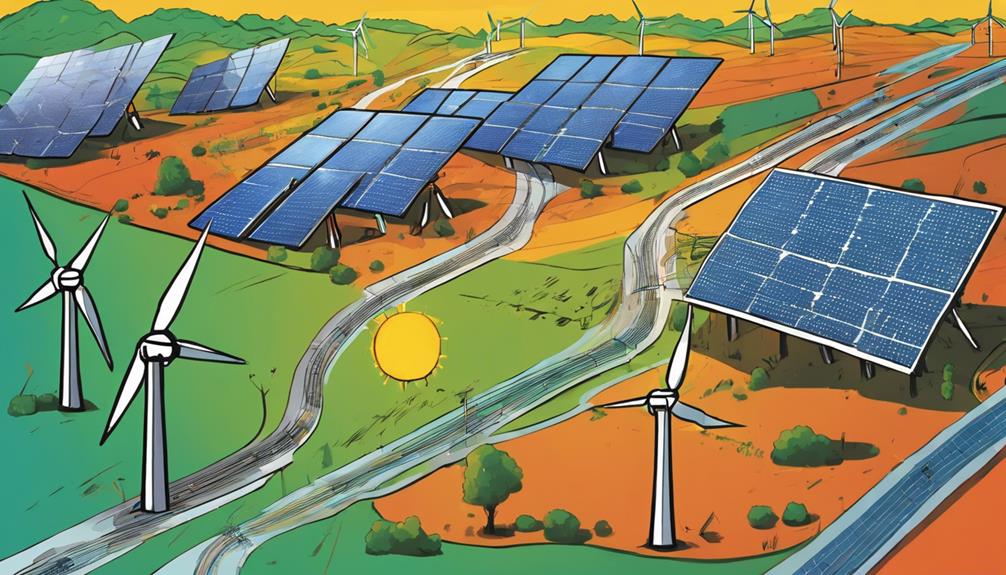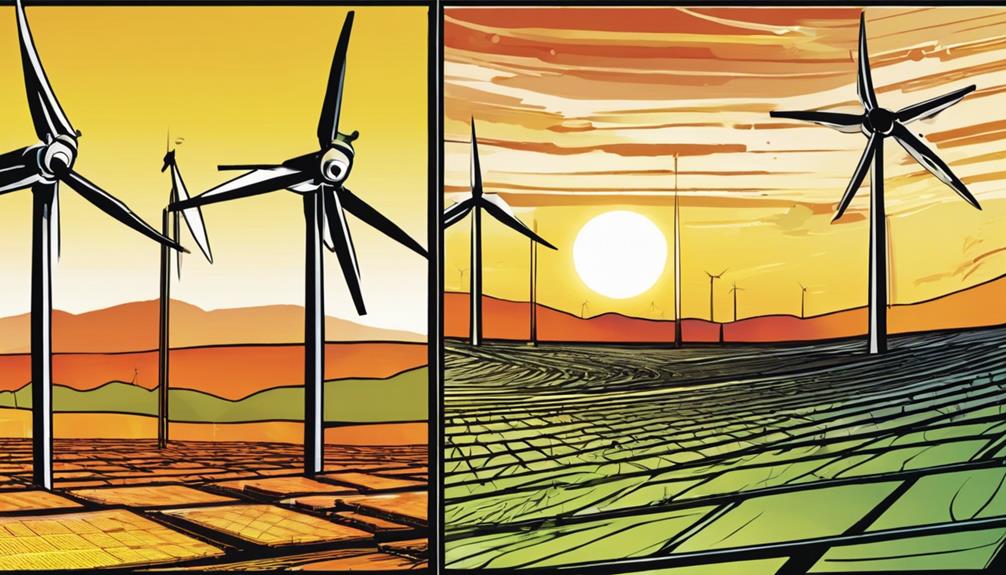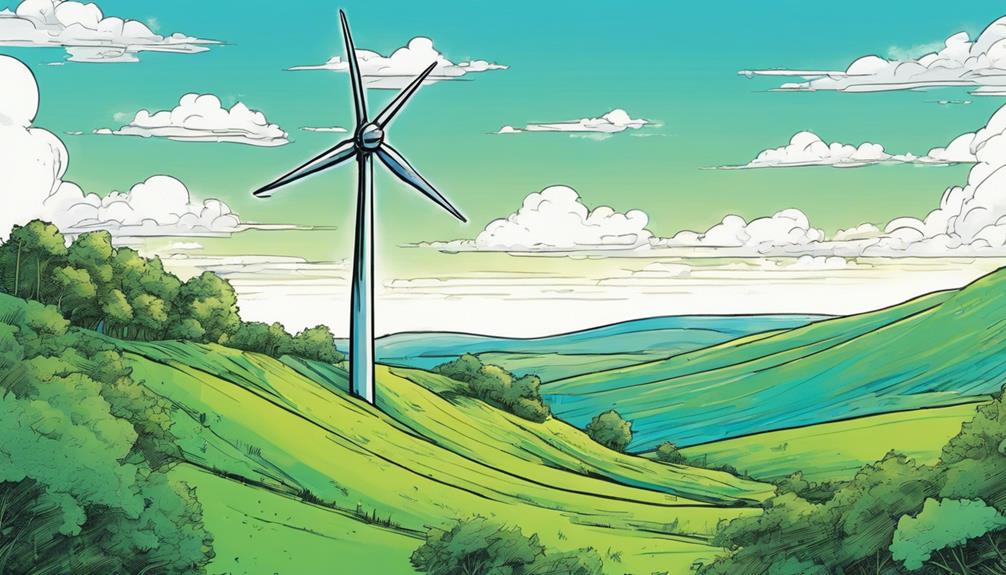When it comes to renewable energy, I'm faced with a tough choice: solar or wind? Both have their perks. Solar power is financially viable, with installation costs decreasing due to competitive pressures and improved practices. Plus, it's more predictable and requires less maintenance. On the other hand, wind energy is more consistent and has a higher capacity factor. But which one is right for me? As I weigh the pros and cons, I'm curious to explore the nuances of each option – and what I discover might just change the game.
Key Takeaways
- Solar power installation costs range from $2.00-$4.00 per watt, making it financially viable for individuals and businesses.
- Wind energy has a higher capacity factor and is more consistent in output, but solar energy is more predictable.
- Solar energy conversion efficiency is up to 22%, while wind turbine systems convert around 50-60% of energy into electricity.
- Solar energy systems require more land for installation, but wind turbines require additional infrastructure, altering the landscape.
- Both solar and wind energy are renewable sources, reducing fossil fuel dependence and promoting economic growth.
Cost Comparison Breakdown

As I explore the cost comparison breakdown, it becomes clear that solar power has emerged as the more affordable option, with installation costs ranging from $2.00-$4.00 per watt, a significant decrease attributed to competitive pressures and improvements in installation practices.
This drop in costs makes solar energy a financially viable option for individuals and businesses. In contrast, wind turbine systems have maintained relatively stable costs. While wind energy conversion is more efficient, with a rate of 50-60% compared to solar's 22%, the upfront installation costs of wind turbines are higher.
Efficiency Analysis Uncovered

I find that solar energy conversion, with an efficiency rate of up to 22%, pales in comparison to wind turbine systems, which convert around 50-60% of energy into electricity. While solar energy has its advantages, its efficiency rate is lower than that of wind energy.
Here are some key differences:
- Efficiency rates: Solar energy conversion is up to 22% efficient, while wind turbine systems convert around 50-60% of energy into electricity.
- Predictability: Solar energy is more predictable than wind energy, but wind energy is more consistent and has a greater capacity factor.
- Maintenance: Solar panels require less maintenance compared to wind turbines, making them a more attractive option for some investors.
Predictability and Reliability

When it comes to generating power, wind energy takes the lead with regard to consistency and capacity factor, whereas solar energy's output can be variable due to weather conditions and daylight hours.
Wind turbines can generate energy over a longer period, making them a more reliable choice. In contrast, solar energy's predictability is affected by factors such as cloud cover and seasonal changes. However, advancements in technology have improved the predictability of solar energy, making it a more viable option.
Despite the differences, both solar and wind energy are renewable sources that reduce our dependence on fossil fuels. As we continue to innovate, I'm excited to see how these clean energy sources will shape our future.
Land Usage Considerations

One key consideration in the renewable energy showdown is that solar energy systems require more land for installation compared to wind turbines. This is because solar panels need to be spread out to capture sunlight effectively, which means they take up more space.
In contrast, wind turbines can be placed closer together, making them a more land-efficient option.
Here are three key differences in land usage between solar and wind energy:
- Space requirements: Solar panels need more space to generate the same amount of energy as wind turbines.
- Infrastructure impact: Wind turbines require additional infrastructure, such as roads and transmission lines, which can alter the natural landscape. Solar energy systems, on the other hand, have a lower environmental impact on land usage.
- Land usage efficiency: Wind turbines are more efficient when it comes to land usage, allowing for more energy to be generated per acre of land.
Key Takeaways Summary

Among the key takeaways from the solar vs. wind energy showdown is that solar power has become a financially viable option, with costs decreasing due to competitive pressures and better installation practices, making it an attractive choice for individuals and businesses alike.
Solar energy conversion is also more efficient, with up to 22% efficiency compared to wind turbines' 50-60%.
While wind energy is more consistent and has a greater capacity factor, solar energy is more predictable and requires less maintenance.
Community solar farms are another advantage, reducing the cost of accessing clean energy and promoting economic growth.
Frequently Asked Questions
Can Solar Panels Be Installed on Residential Rooftops With Varying Angles?
"Absolutely, I can install solar panels on residential rooftops with varying angles. In fact, angled rooftops can even help with snow removal and debris accumulation, making maintenance a breeze!"
How Do Wind Turbines Affect Local Wildlife and Ecosystems?
'As I explore the world of renewable energy, I've found that wind turbines can be a double-edged sword for local wildlife, providing refuge for some species while disrupting habitats and migratory patterns for others.'
Are There Government Incentives for Renewable Energy Installations?
Yeah, I've got some good news There are indeed government incentives for renewable energy installations, like tax credits and grants, to encourage individuals and businesses to go green and reduce their carbon footprint.
Can Solar Energy Be Stored for Later Use During Nighttime?
"I'm impressed that solar panels can convert up to 22% of sunlight into electricity. Yes, solar energy can be stored for later use during nighttime through batteries, like Tesla's Powerwall, or other energy storage systems."
Are Wind Farms and Solar Farms Compatible With Agricultural Land Use?
"Yes, wind farms and solar farms can coexist with agricultural land use. In fact, community solar farms can promote economic growth while allowing farmers to continue using their land productively."
Which Type of Renewable Energy Has the Higher Energy Potential – Solar or Wind?
When looking at the lattice energy comparison nabr vs. cacl, it’s important to consider the higher energy potential between solar and wind power. While both are viable options, solar energy often has a higher potential due to its ability to collect and store energy from the sun’s rays, making it a more consistent and reliable source.
Can Wind Energy Be Utilized at Night Similar to Solar Energy?
Wind energy can be utilized at night, just like using solar energy at night. Wind turbines can still generate electricity during the night when the wind is blowing. This makes wind energy a reliable source of renewable energy that can complement solar energy in providing power around the clock.
Conclusion
As I weigh the pros and cons, it's clear that both solar and wind energy have their strengths and weaknesses. But, as the adage goes, 'a bird in the hand is worth two in the bush.'
For me, the decreasing costs and improving efficiency of solar power make it the more promising choice. While wind energy's consistency and land usage advantages are enticing, solar's potential for widespread adoption and innovation tips the scales.
In the end, it's not a question of either/or, but rather how we can harness the power of both to create a sustainable future.










